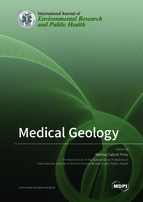Medical Geology
A special issue of International Journal of Environmental Research and Public Health (ISSN 1660-4601). This special issue belongs to the section "Environmental Health".
Deadline for manuscript submissions: closed (31 July 2020) | Viewed by 48367
Special Issue Editor
Interests: soils; water; exposure and health
Special Issues, Collections and Topics in MDPI journals
Special Issue Information
Dear colleagues,
All living organisms are composed of major, minor, and trace elements supplied by local geology. Such elements occur in varying concentrations and forms throughout the atmosphere, lithosphere, and hydrosphere. As a result, plants, animals, and humans are exposed regularly to these elements. With respect to each essential element, all organisms depend on a specific range of tolerance or adequate range of exposure that is safe. Deficient or excess levels of concentration for the essential elements can lead to adverse health effects and, in certain cases, death. Medical geology links the influence of natural geological and environmental benefits and risk factors on the distribution of health problems in humans and animals.
The composition of rocks and minerals is imprinted on the air that we breathe, the water that we drink, and the food that we eat. For many people, this transference of trace elements from minerals is beneficial as they are the primary source of nutrients (such as calcium, iron, magnesium, potassium, and about a dozen other elements) that are essential for a healthy life. However, sometimes, the local geology can cause significant health problems because there is an insufficient amount of an essential element or an excess of a potentially toxic element (such as arsenic, mercury, lead, fluorine, etc.), or a harmful substance such as methane gas, dust-sized particles of asbestos, quartz or pyrite, or certain naturally occurring organic compounds.
Global environmental threats have historically been largely ignored in terms of health, despite their enormous impact on both people and planet. The cause, involvment and/or spread of infectious, neurodegenera, carcinogenic, and other diseases is influenced by climate change and environmental pollution as well as poor water quality and sanitation, food insecurity, environmental degradation, loss of biodiversity, natural and anthropogenically caused disasters, and poor governance. Thus arises the urgent need to bring a multidisciplinary approach combining diverse areas, such as infectious, carcinogenic, neurosciences, psychology, and environmental sciences and integrating socioeconomic, neuropsychological, and environmental/health data.
This Special Issue of IJERPH discusses recent advances in medical geology, providing examples from research conducted all over the world. Among the topics to be discussed are:
- Health effects from trace elements, metals, and metalloids;
- Regional and global impacts of natural dust (including the study of nanoparticles);
- Chemical and environmental pathology of diseases associated with the natural environment;
- Novel analytical approaches to the study of natural geochemical and environmental agents;
- Research on beneficial health aspects of natural geological materials;
- Risk management, risk communication, and risk mitigation in medical geology;
- Remote sensing and GIS applications in medical geology;
- Epidemiology and public health studies in medical geology;
- Climate change and medical geology;
- Clinical and toxicological research on biomarkers of exposure;
- Veterinary medical geology;
- Biosurveillance and biomonitoring studies in medical geology.
Dr. Marina Marques da Silva Cabral Pinto
Guest Editor
Manuscript Submission Information
Manuscripts should be submitted online at www.mdpi.com by registering and logging in to this website. Once you are registered, click here to go to the submission form. Manuscripts can be submitted until the deadline. All submissions that pass pre-check are peer-reviewed. Accepted papers will be published continuously in the journal (as soon as accepted) and will be listed together on the special issue website. Research articles, review articles as well as short communications are invited. For planned papers, a title and short abstract (about 100 words) can be sent to the Editorial Office for announcement on this website.
Submitted manuscripts should not have been published previously, nor be under consideration for publication elsewhere (except conference proceedings papers). All manuscripts are thoroughly refereed through a single-blind peer-review process. A guide for authors and other relevant information for submission of manuscripts is available on the Instructions for Authors page. International Journal of Environmental Research and Public Health is an international peer-reviewed open access monthly journal published by MDPI.
Please visit the Instructions for Authors page before submitting a manuscript. The Article Processing Charge (APC) for publication in this open access journal is 2500 CHF (Swiss Francs). Submitted papers should be well formatted and use good English. Authors may use MDPI's English editing service prior to publication or during author revisions.






